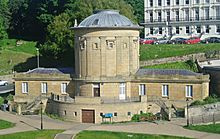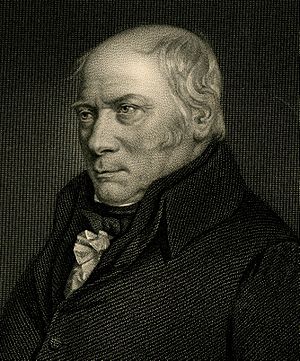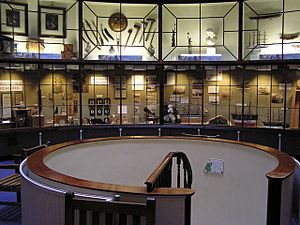Rotunda Museum facts for kids
 |
|
| Lua error in Module:Location_map at line 420: attempt to index field 'wikibase' (a nil value). | |
| Established | 1829 |
|---|---|
| Location | The Rotunda Museum,
Vernon Road, Scarborough, North Yorkshire YO11 2NN |
| Type | Geological |
| Visitors | Open Tue–Sun, 10 am–5 pm |
The Rotunda Museum is a super old and special museum in Scarborough, North Yorkshire, England. It was built way back in 1829, making it one of the very first museums built just for showing off cool stuff in the whole United Kingdom. This amazing round building holds one of the best collections of Jurassic fossils and rocks found along the Yorkshire Coast. It's like a time capsule for ancient Earth!
Contents
How the Rotunda Museum Started
The Rotunda Museum is known as one of the best old museums still standing. It was built in 1829 by an architect named Richard Hey Sharp from York. The idea for its unique round shape came from William Smith. He is often called the "Father of English Geology."
William Smith's Big Ideas
William Smith was a very important geologist. He figured out that you could identify and match up different layers of rock using the fossils found inside them. This was a huge discovery! Smith came to Scarborough because the Yorkshire Coast has lots of interesting Jurassic rocks and fossils.
Building the Museum
Sir John Johnstone became a big supporter of William Smith. He hired Smith to help manage his land. Sir John was also the head of the Scarborough Philosophical Society. This group raised the money to build the Rotunda Museum. They asked Smith for his ideas on how the museum should look.
Sir John was a young leader in Scarborough in the 1820s. He strongly believed in Smith's ideas. He even gave the special Hackness stone used to build the museum. Smith had seen a round building in London and told the architect, Richard Sharp, to use a similar design.
The Original Displays
The Rotunda Museum was built just as William Smith suggested. The first displays showed off his amazing ideas. Fossils and rocks were placed in a special order. The newest ones were at the top, and the oldest ones were at the bottom. This showed how rocks are layered in the Earth.
The order of rocks around the museum walls matched the order of rocks found along the Yorkshire Coast. Smith's nephew, John Phillips, who was also a geologist, drew a picture of the coast's rock layers around the inside of the museum's dome. Later, in 1860, two extra sections were added to the building.
Amazing Fossil Collection
The Rotunda Museum has a huge collection of over 5,500 fossils and 3,000 minerals! Many of these are "type specimens." These are the very first examples of a fossil that scientists ever described. The museum also has one of the best collections of Middle Jurassic fossil plants in the country.
What You Can See
The collection includes many different types of fossils:
- Cretaceous fossils from the Speeton Clay and Chalk.
- Lots of Upper and Lower Jurassic specimens.
- Ice Age fossils, like mammoth teeth.
- Fossils from the famous Kirkdale Cave.
- A perfect collection of Carboniferous plants.
All these amazing items were carefully organized and preserved in 2007. The most exciting ones are now on display in the museum. They give you a great idea of the quality and variety of fossils and minerals found along Yorkshire's "Dinosaur Coast." This coast stretches from Redcar in the north to Flamborough in the south.
Museum Makeover
Scarborough Borough Council wanted to make the museum shine again. They wanted it to be a top place for showing off geology. They received a big grant of £1.8 million from the Heritage Lottery Fund. They also got money from the European Regional Development Fund and over £1.5 million from other groups and people.
With help from English Heritage, the project aimed to make the museum a great starting point for exploring the area's Dinosaur Coast. They added a new entrance and a lift to make it easier for everyone to visit. The makeover also honored William Smith, the museum's original designer.
What Was Done
A company called William Anelay Limited did important repair work on the outside stone. They also put a new lead roof on the dome. Inside, some walls were taken down, and a new section was built at the front. This new part created a fresh entrance, offices, and restrooms. It also made it possible to enter the building from the path at the basement level.
The old spiral staircase was carefully removed and stored. A new one was put in, with space for a lift in the middle. The museum was closed during this big restoration. It reopened in May 2008, looking brand new!
Restored Display Cabinets
Some unique glass display cabinets from 1850 were also restored. These cabinets were originally designed to show off William Smith's work. They were taken from the upper gallery, cleaned, and repaired. Tim Phelps and his team near Knaresborough did this special work.
Now, these cabinets display cool items like a model of George Cayley's first flying machine. You can also see an early steam car model by Sir Edward Harland. The lower parts of the cabinets hold fossils, rock samples, and minerals.
Shell Geology Now! Gallery
Shell was the biggest company to donate money for the makeover. They sponsored the "Shell Geology Now!" gallery. This part of the museum explores current geological and environmental research. It helps visitors understand how geology affects our world today.
The museum officially reopened on Friday, May 9, 2008, after its two-year, £4.4 million refurbishment. It was renamed The Rotunda – The William Smith Museum of Geology.
From 2005 to 2025, the museum was managed by Scarborough Museums Creative and Cultural Trust. After that, it was returned to North Yorkshire Council.



